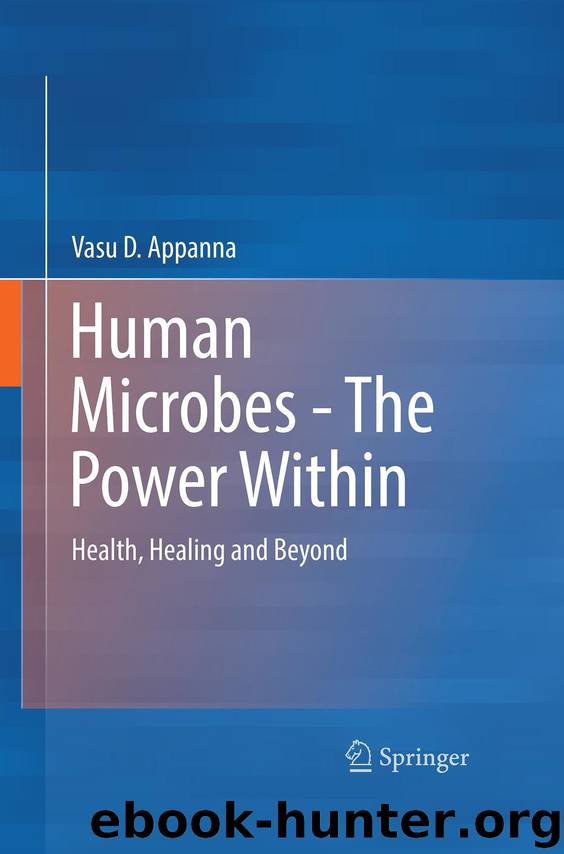Human Microbes - The Power Within by Vasu D. Appanna

Author:Vasu D. Appanna
Language: eng
Format: epub
Publisher: Springer Singapore, Singapore
Fig. 3.4Sugary diet and dental cavities. (The organic acids produced by the imbalanced microbial community decrease the pH and attack the enamel; hypothiocyanite is a potent antimicrobial agent)
3.3 Distressed Microbial Communities in the Mouth: A Smelly and Painful Concern
The mouth is another part of the body that lends itself to constant contact with the invisible world. As it is an extension of our environment, the microbial traffic is high. Anytime we open our mouth to eat, drink, laugh, smile, yawn or cry, we are enabling millions of microbes to access our body. However, due to the vigilant watch of resident oral microbes and their anti-microbial components, only a select few can contemplate to occupy a piece of the real estate either in our mouth or lungs. The microbial communities composed of diverse constituents that set foot are scrupulously and carefully interrogated by our molecular sentinels. Interactions with prospective residents are permitted only if they work for a common purpose. Only when a member can contribute to a specific function that the community depends on, the microbial member is accepted and a shelter is made available. The contribution of each of the member is critical for the functioning of the community.
However, this situation can rapidly change specially in the mouth where there is a constant flux of diverse exchanges occurring with respect to microorganisms. Furthermore the buccal chemical landscape also undergoes tremendous fluctuation due to the regular intake of foods and drinks. This situation can be complicated if one allows any food component to remain in the mouth for too long. Carbohydrate-rich nutrients become easy prey on which some opportunistic microbes can thrive. Despite the vulnerability of the mouth to possible invisible intruders, the microbial population is kept in check by the watchful guard of other community members including the host. For instance, in the establishment of dental caries, the Streptococcus mutans utilizes these sugary goodies stuck on the tooth to produce lactic acid, an event that increases the acidity of the buccal ecosystem. This presents an opportune situation for other microbes like the Veillonella and Lactobacillus salivarus/acidophilus to colonize this territory and further aggravate the affliction on the tooth (Fig. 3.4). The fine microbial balance that is perturbed as a result of ensuing chemical change in the mouth is an ongoing concern for people especially children with poor dental hygiene. This disruption and the resulting medical complication can be averted by controlling the chemical landscape in the mouth. Halitosis is also caused by microbial disruption that results in the increase in H2S, a molecule responsible for smelly breath. This may also be aggravated by the genetic make-up of the host (Fig. 3.5).
Download
This site does not store any files on its server. We only index and link to content provided by other sites. Please contact the content providers to delete copyright contents if any and email us, we'll remove relevant links or contents immediately.
| Administration & Medicine Economics | Allied Health Professions |
| Basic Sciences | Dentistry |
| History | Medical Informatics |
| Medicine | Nursing |
| Pharmacology | Psychology |
| Research | Veterinary Medicine |
Tuesdays with Morrie by Mitch Albom(4692)
Yoga Anatomy by Kaminoff Leslie(4306)
Science and Development of Muscle Hypertrophy by Brad Schoenfeld(4089)
Bodyweight Strength Training: 12 Weeks to Build Muscle and Burn Fat by Jay Cardiello(3915)
Introduction to Kinesiology by Shirl J. Hoffman(3725)
How Music Works by David Byrne(3187)
Sapiens and Homo Deus by Yuval Noah Harari(2987)
The Plant Paradox by Dr. Steven R. Gundry M.D(2547)
Churchill by Paul Johnson(2506)
Insomniac City by Bill Hayes(2498)
Coroner's Journal by Louis Cataldie(2432)
Hashimoto's Protocol by Izabella Wentz PharmD(2331)
The Chimp Paradox by Peters Dr Steve(2297)
The Universe Inside You by Brian Clegg(2097)
Don't Look Behind You by Lois Duncan(2080)
The Immune System Recovery Plan by Susan Blum(2029)
The Hot Zone by Richard Preston(1983)
Endure by Alex Hutchinson(1964)
Woman: An Intimate Geography by Natalie Angier(1882)
